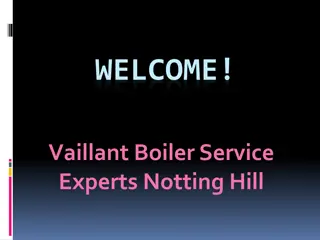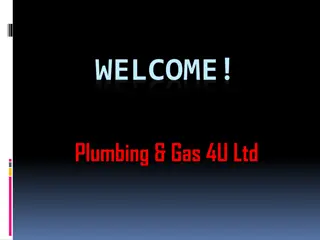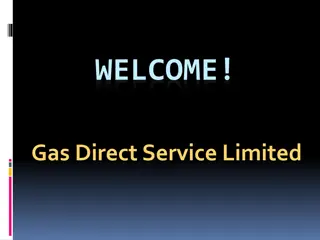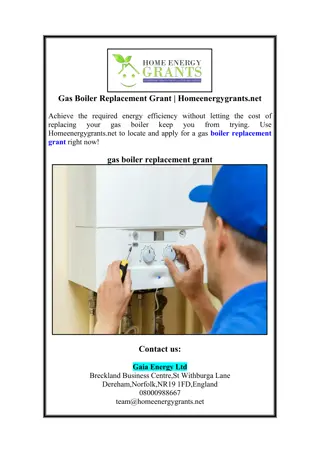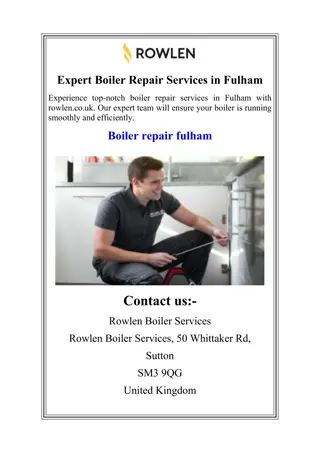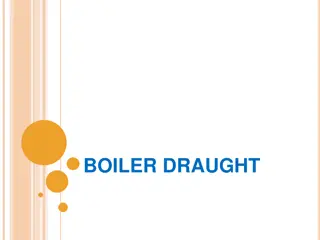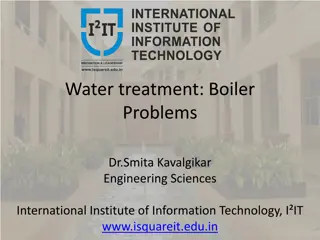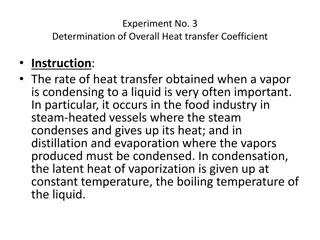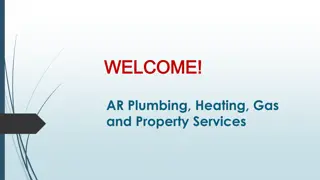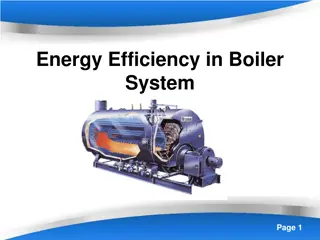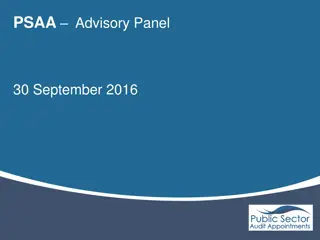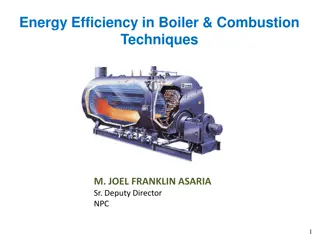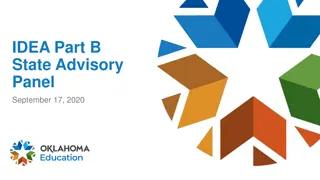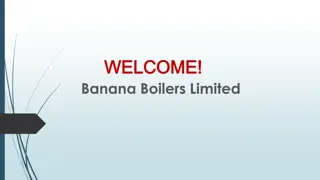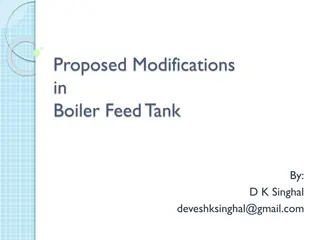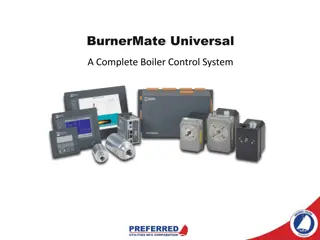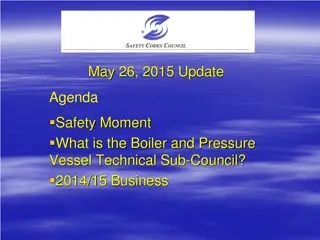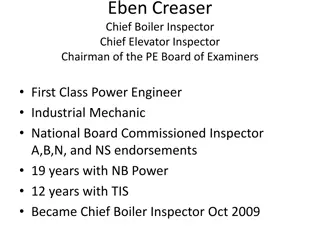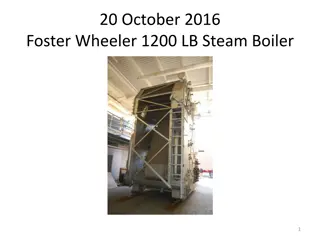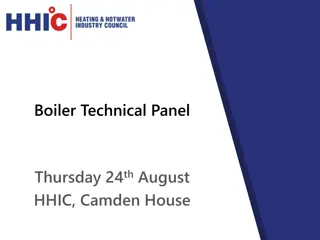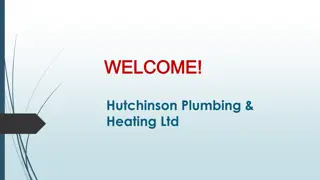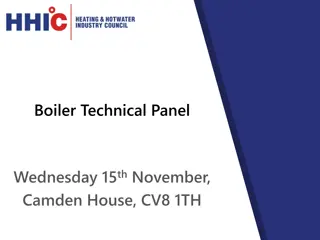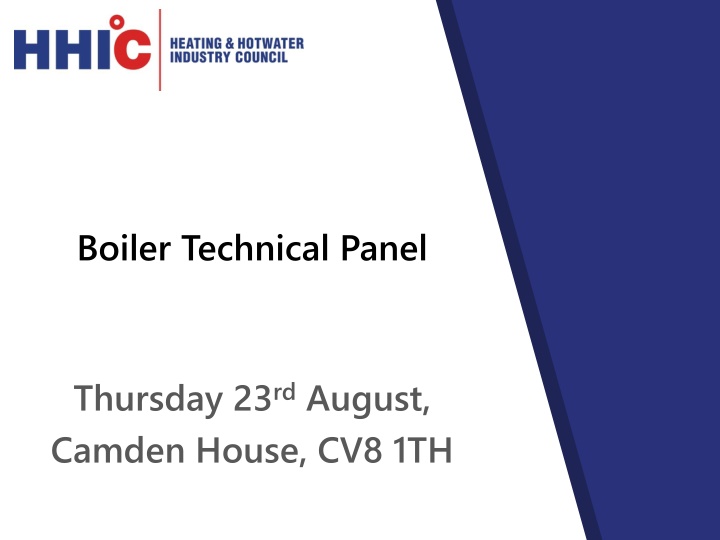
Boiler Technical Panel Meeting Summary
The Boiler Technical Panel meeting on Thursday, 23rd August at Camden House discussed various matters, including apologies received, compliance with The Competition Act, ongoing actions, and updates on industry regulations and initiatives.
Download Presentation

Please find below an Image/Link to download the presentation.
The content on the website is provided AS IS for your information and personal use only. It may not be sold, licensed, or shared on other websites without obtaining consent from the author. If you encounter any issues during the download, it is possible that the publisher has removed the file from their server.
You are allowed to download the files provided on this website for personal or commercial use, subject to the condition that they are used lawfully. All files are the property of their respective owners.
The content on the website is provided AS IS for your information and personal use only. It may not be sold, licensed, or shared on other websites without obtaining consent from the author.
E N D
Presentation Transcript
Boiler Technical Panel Thursday 23rdAugust, Camden House, CV8 1TH
1. Welcome and Apologies Apologies received from: Alister Maclachlan Vokera, Martin Butcher Vaillant, Sean Keleher Atag, Mike Hook Biasi, Louis Pickersgill - Ravenheat
2. The Competition Act Members are reminded of the requirements of The Competition Act: As a reputable trade association, HHIC s meetings must comply with the requirements of The Competition Act. This means that we must avoid any discussion that could be construed as being anti-competitive and in particular there must be no discussion about pricing of products and services. By attending this meeting and having your names included in the minutes, all participants confirm that they agree to comply with this policy.
3. Matters arising (May 23rd) 1) NM advised that HHIC were still chasing BEIS (Sarah Montgomery) for a breakdown of PCDB listing cost. SS advised that if an answer was not forthcoming he would look to approach KIWA directly, as PCDB gatekeepers. ACTION: HHIC remains open, Sarah advised yesterday (22ndMay) that her team are still pursuing this Email from Katy Read (BEIS policy lead, Energy Performance of Buildings) 14thJune: .The fees cover costs of Gastec and BRE in (1) receipt, validation, and invoicing, (2) checking data, evidence and identification (3) database upload, (4) any ad-hoc advice and (5) processing amendments. As you can see from the table, other technologies are on a par with these costs. One option is that we wait until the PCDB application portal has been enhanced and then remove the subsidisation of the fee if this would enable a smoother transition to the fee change - your thoughts are welcome .
3. Matters arising (May 23rd) 2) BRE paper on efficiency checking - SS advised that he would be meeting with Will Griffiths later in the week to discuss Hybrids and would raise/discuss this again. ACTION: SS? 3) Solar pre-heating max inlet temperatures for combi boilers - MB felt that there would be no harm in resending the spreadsheet to members as a voluntary exercise. ACTION: NM Complete, no responses received 4) WEEE - ACTION: HHIC to maintain previously agreed positions, but engage with DEFRA as they collate the results of their consultation on this topic (see T18 0114), and continue to assert these views No further contact from DEFRA, previously received letter from Ian Smirthwaite (DEFRA) lies on file supporting HHIC view that fossil-fuel boilers are out of scope 5) ErP Space Heating Efficiency members to review installation literature for prominence of figure ?
3. Matters arising (May 23rd) 6) This appliance must only be installed by a Gas Safe registered engineer livery on appliance packaging; HHIC to propose wording, members to review ..Covered by agenda (A.O.B. reminder) 7) ACTION: HHIC to update EHI on UK view, noting uncertainty around whether 3rdparty verification would be extended to other new criteria which may be introduced by the review Complete, covered by agenda 8) Controls workshop outputs - It was discussed that HHIC had not had recent contact with Colin Timmins on HHIC/BEAMA controls workshop outputs, but would chase. ACTION: SS Complete, workshop outputs circulated, Colin advises there are no additional, supporting documents 9) WRAS proposals ACTION: HHIC to feedback questions and comments COMPLETE & covered by agenda
3. Matters arising (May 23rd) 10) Drinking Water Directive - ACTION: HHIC TO CONTACT EHI TO SEEK GREATER CLARITY ON PROPOSALS AND EXPRESS CONCERNS AROUND CPR COMPLETE (email below from EHI dated 28thMay) Why mention the CPR for products in contact with drinking water? The European Commission proposal for the revision of Article 10 of the DWD, published on 1st Feb 2018, favours legislating hygienic requirements for materials and products in contact with drinking water via the Construction Product Regulation (CPR). However, the scope of the CPR excludes a number of products that should be covered by the DWD. It is why the EDW (European Drinking Water) alliance proposed that CPR harmonised standards should be used to determine requirements for non-CPR products (including lists of accepted substances, generic hygienic requirements, common test methodologies and a labelling system separate to the CE Mark), BUT the CPR scope should not be extended to products not currently covered by the CPR. At the EHI Dept. 13 Meeting on 11 April 2018, EHI Members supported this approach and amended EDW amendment proposal. This change was then accepted by EDW. Refocus of the debate on the DWD for products in contact with drinking water: Since then, there have been positive developments in the European Parliament that refocused the debate on the DWD itself: MEP Michel Dantin issued his draft report that looks a good and promising starting point because it acknowledges that EU- wide hygienic requirements should be set under the Drinking Water Directive. Several amendments on materials and products in contact with drinking water inspired by the EDW suggestions (see attached document). They aim to strengthen the DWD for products in contact with drinking water and especially require that the European Commission be empowered to adopt delegated acts in accordance with Article 19 in order to supplement this Directive by determining the minimum hygiene requirements and the list of substances and materials coming into contact with water intended for human consumption authorised within the Union (Amendment 74). In addition, this amendment requires that products covered by the CPR shall compliance with the DWD.
3. Matters arising (May 23rd) Email from European Commission (Manfred Fuchs DWD desk officer; 18th June) It took a little bit longer but we still have some discussions with DG ENV. The Commission (yours truly) has decided to split the mandating work into two (complementary) parts: a mandate for the design and installation work of the system of water supply a mandate for specific products used in these systems There are several reasons: First, to avoid a "Super-Mandate" like M/136 which was way too big to cover all requirements properly and makes it difficult to check which elements have been done and which are still open. Second, since two different groups of experts are needed for the system approach and the product approach, it is easier that experts are replying only to the part they are actually covering and not mixing it in their reply to the mandate. Last but not least: By looking at a whole supply system the EC can better define the role of specific products and which performance should be declared in the product standards. After issuing the mandate there will be a phase when the Commission will see if there is actually enough support for the standardisation work and enough experts are working on these horizontal technical documents. Lobbyists and civil servants are declaring how interested they are but their actual input in the mandating work so far was rather disappointing. If there is not enough support, we will stop the standardisation work at that stage because we have to avoid to repeat the mistake from last time (M/136) that for years officially CEN was working but in reality the work came already to a complete standstill. If there is enough support, we will start phase two which is the mandate for products. Currently, these would be the milestones for the work:
3. Matters arising (May 23rd) Horizontal technical specifications Milestone deadline Starting work on standardisation request May 2018 Commission Decision May 2019 CEN delivery May 2021 Product standards Milestone deadline Starting work on standardisation request October 2018 Commission Decision December 2019 CEN delivery Mid-2022
3. Matters arising (May 23rd) 11) NHBC HW guidance (inc. 7C mains inlet temp rationale?) - MB advised that HWA had produced a minimum KW rating interpretative document for each scenario, which it was requested HHIC seek to obtain and circulate. ACTION: NM Complete, and covered by agenda 12) TD wondered about GDPR impact on the data proposed to be recorded. ACTION: NM to circulate email from Gas-Safe-Register, obtained for HHIC Installer Committee, which may be of interest - Complete 13) SS advised that Simon Froggatt (Worcester-Bosch) was also close to this work, and that he had offered to brief members in person if this was acceptable and desired. This could possibly be a joint HHIC/ICOM session. ACTION: SS to investigate/propose Complete, seminar arranged for Monday 17th September (reminder in AOB)
3. Matters arising (May 23rd) 14) - Press for 11TP topics .summer servicing? - MB suggested something focused on checking boiler condensate arrangements in summer, ahead of winter weather. ACTION: NM Complete, mentioned in HHIC summer servicing article in HVP, also feeding into frozen condensate actions/guidance 15) Non boiler-manufacturer eligibility for 11TP meetings/comms - There were no objections to the proposed action (boiler manufacturers only), with it just requested that HHIC mail absent members to cover all due diligence, and check 11TP distribution list for currency. ACTION: NM - Complete
4. Frozen boiler condensate Update from Steve Sutton on progress and group review of latest draft guidance document (T18 0135) & diagrams
5. EcoDesign Lot 1 & 2 Review - email from EHI (2nd August): .More generally, in the light of the diesel scandal, heater manufacturers understand that maintaining the current 3rd party conformity assessment procedure for boiler energy efficiency is needed, but they do not favour any extension to additional parameters or additional products. One exception to this is for biomass boilers: EHI members favoured the extension of 3rd party conformity assessment to biomass boilers at the last EHI Department 10 meeting, on 26 June 2018. Last but not least, as new additional Ecodesign requirements (e.g. hydrocarbons, CO) could be introduced in the future and/or testing conditions could be modified to reflect better real-life, we are reluctant to provide proactive EHI views on 3rd party conformity assessment to the consultant VHK in charge of Lot 1 & 2 review ..
5. EcoDesign Heat pumps (EHI comments on 3rd party conformity assessment): from the recent feedback received from EHI manufacturers, threats of a 3rd party conformity assessment for heat pumps seem to overrule the few and uncertain advantages (see attached internal briefing note pp.3-4). If 3rd party conformity cannot be avoided, several heat pump manufacturers are of the opinion that the conditions should be designed as close as possible to the existing private label certification schemes . HHIC contact with BEIS HHIC met with Marvin Taylor (direct Mike Rimmer replacement) & Adrian Barker on 1st August. We have advised that we are working on a concrete HHIC view on 3rd party conformity assessment, but have reiterated the EHI position at this time, including a leaning towards favouring 3rd party certification (boiler efficiency), important as EHI had indicated that Mike had expressed a view that the UK was not very supportive of 3rdparty verification ..
5. EcoDesign Question from BEIS?....... How many boiler manufacturers have the ability to assess boiler efficiency in house ?
5. EcoDesign Lot 11 circulators (integrated circulator spares exemption); EHI update (2nd August) .New timeline? The European Commission will present a Working Document to revise the Ecodesign Regulation for circulators in early 2019, together with the final study results (see EHI Briefing 1146 on the review study final report). This Regulation review is however not a priority for the European Commission (EC) as compared to other product groups that will be part of the winter Ecodesign and Energy Label package expected in January 2019 and will include refrigerators, dishwashers, washing machines, televisions / computers (electronic displays) and lighting products, motors, industrial fans and external power supplies ..
5. EcoDesign .In addition, Ronald Piers informed me that the EC is still considering postponing the exemption for integrated circulators by 2 years ( i.e. from 2020 to 2022). Why? Because it would apply the same transition period of 7 years than it has proposed for integrated motors (see attached the Ecodesign proposal for motors currently in inter-service consultation at the EC). However, if proposed by the EC, the adoption and publication in the EU Official Journal of a revised circulator Regulation with additional 2 year transition for integrated circulators would most probably happen after the end of the transition for integrated circulators i.e. after 1 January 2020.What s more, additional delays in its adoption process may be caused by several factors: new College of Commissioners in 2019, stricter impact assessment procedure, adoption of Ecodesign and Energy Labelling Regulations in so-called packages . Please also note that the cascading issue is one of the main reasons justifying the recent negative opinion on the fan Regulation review from the Impact Assessment Board.
5. EcoDesign What is EHI doing? EHI is finalising an overview for DG ENER of heater manufacturers input showing concretely the impact of switching from old to new integrated circulators, and quantifying how many products are at stake. EHI will then share this feedback with other DGs within the EC, especially DG GROWTH. National actions would also be needed with the Members of the Ecodesign Consultation Forum to advocate for extending the transition period, and we will come back to you with suggestions at the end of the summer.
5. EcoDesign Lot 38 Building Automation Control Systems (BACS) HHIC have joined EHI Dept. 5 to have input into Lot 38 EHI are preparing a detailed analysis of Lot 38 scoping report and inviting suggestions for an EHI response to Lot 38 exploratory study (positions requested)
5. EcoDesign Energy Labelling / EPREL database mock-up templates for products, inc heaters, combination heaters, temperature controls & packages now available (circulated by HHIC) Possible delays expected to EPREL database implementation (1st January 2019), either database itself or for individual product lots (a watching brief) Several EC consumer energy labelling review studies now available, not encompassing products within the HHIC remit, but believed to be relevant as the Commission may act on recommendations and seek to implement also for products closer to home , e.g. new noise icon?
6. Hy4Heat WP2 (Lot 1 hydrogen standards) now awarded to IGEM consortium (inc. HSL, DNV GL, Global Energy Associates Ltd.), without competitive tender. HHIC expect to be members of and/or actively involved in the stakeholder group for this WP. Lot 2 (development of hydrogen colourant) ITT has been published, contracts not yet awarded (to HHIC knowledge at time of writing) WP3 launch event held on 7th August, which Arup used to firm up on their plans for a technical governance committee, to develop the appropriate guidance to support certification of hydrogen appliances. Again, HHIC expect to be involved. There is a suggestion that relevant installation British Standards, e.g. BS 6891 (being non-IGEM and so not covered in WP2) could be encompassed within this lot, something HHIC are pursuing Arup for clarity on. Arup also assessing sites suitable to support the R&D and test regimes, i.e. those with or able to provide a supply of hydrogen, bays where appliances can be installed etc. WP4 pre-commercial approach to be taken, with a gate methodology to whittle entrants down to preferred bidders. No update on PIN or ITT at time of writing, BEIS/Arup are aware of industry concerns over just how far funding will go once apportioned out amongst different appliances and bidders
6. Hy4Heat ISO DIS 14687 (Hydrogen fuel quality product specification) is out for voting via PV/3/8 (UK mirror to CEN-CENELEC TC6), the standard now being drafted as an amalgamation of the various parts of previous iteration (1999) It is this standard from which the Hy4Heat base hydrogen fuel specification for domestic appliances has been advised as will be drawn (type 1, grade A, 98% purity) Current work believed to be focused on combining all previous parts, and a change to vehicle purity requirements
7. IGEM gas pressure report Draft report produced and circulated within WG (inc. HHIC); circulated to HHIC members for comment Comments resolution meeting believed to be scheduled for 27th September, HHIC are enquiring as to whether we can/should participate HHIC response multiple comments Report unclear amalgamation of select minuted extracts GDN process listed does not fall in line with recommendations Manufacturers may continue to require installation full-load for commissioning All HW taps required to be opened for DHW appliance ESP should be open to RGE assistance to operate in high fire rate 20mb should be the norm, no dumbing down The ESP/GDN has a duty of care to ensure safety, worst case load conditions should be employed Broad acceptance that appliance must be safe at 17.5mb appliance inlet working pressure
8. Combustion readings required to confirm safe operation Request from LBF to discuss, with the suggestion there may be some interest from the HSE in this topic Email to HHIC from Trevor smallpeice (LBF chair): Hi Neil I have an action from this week s LBF around Air/Gas Ratio Valves (AGRV). We discussed this issue and it was highlighted that there have been some incidents arising from their improper adjustment and operation and there was a feeling there were some unclear manufacturer s instructions in that some only asked for one measurement i.e. Co2 or Ratio. Could you bring this up at the appropriate HHIC manufactures meeting that we feel there should be consistent testing requirements for all boilers both commissioning and maintenance Many thanks
8. Combustion readings required to confirm safe operation HHIC are aware of a discrepancy in the combustion reading format requested between Benchmark commissioning and service records, which will be reviewed alongside other form criteria as part of a wider Benchmark review. Also discussed by spares sub-group in relation to job record template If any UK boiler manufacturer is only asking for one parameter (e.g. CO, CO2, CO/CO2 ratio, O2), would they be willing to list more comprehensive guidance to confirm safe combustion?
9. Siloxanes At the IGEM Gas Quality Working Group meeting on June 21st, HHIC again made the point that the stakeholder event promised at the outset of the DNV GL project had not materialised, and that unanswered questions remain. Chair Gus McIntosh (SGN) requested that IGEM take an action to now arrange this, but 8 weeks later, and with minutes still not circulated, HHIC have been chasing for an update that this commitment will be honoured (no word at time of writing) On June 21st, it was said by Gus that he believed, based on the DNV GL findings, that SGN has since specified 0 mg Si/m3 for network entry agreements, a view also volunteered as the case by another GDN (informally). Whilst measurability remains a problem at such low levels, it was suggested that, should the GDN audit the contractor via the conventional, not in real-time methods, and siloxanes be detected, that they could then be in breach of contract, and potentially removed as a supplier. This is all anecdotal at present, hence HHIC again writing to IGEM for clarity. At this time we have not written to individual GDN s to request their position, although this remains a potential future option.
10. HSE cost-benefit-analysis mapping 53.25 MJ/m3 (WI) HHIC have requested that natural gas appliance manufacturers should be listed as a separate domestic stakeholder group Are there any views on costs vs benefits for manufacturers, should HSE accept the case for change to increase the upper UK WI limit to 53.25 MJ/m3?
11. Building Regulations & SAP SAP 10 (updated methodology for the Standard Assessment Procedure) published on BRE s website in July, reflecting Govt. response to last SAP consultation: https://bregroup.com/sap/sap10/ Published to allow readers to compare it to SAP 2012 and understand the methodological changes made ahead of any future official use. The method will need further changes ahead of its eventual use. SAP 2012 continues to be used for Building Regulation compliance and for producing Energy Performance Certificates until further notice. Upcoming consultation on Part L of the Building Regulations expected this winter, and that it will be published alongside a more current SAP 10.01 (e.g. with updated fuel factors), to consider official adoption of SAP 10. Revised Part L expected to be published October 2019 or April 2020, alongside SAP 10.02
11. Building Regulations & SAP SAPIF HHIC are participating in new SAPIF forum, beginning to proactively consider issues which may be necessary/relevant for a future SAP 11
11. Building Regulations & SAP SAP HW summer efficiency error HHIC have been contacted by a member who has been in contact with BRE and advise that that there is an error in SAP with calculating SAP Summer Efficiency. We have contacted Will Griffiths and he has written to BEIS with a correction for the methodology when calculating SAP Summer Efficiency using M and L profiles. As you know there are different ways to put combi boiler test data in the PCDB: No test data (gives a standard default combi hot water efficiency and heat loss) M water profile M & L water profile We believe manufacturers have found that when listing your products that in most cases the M profile gives the best result however BRE advise that you should have better efficiency using the two profiles ( M and L)
11. Building Regulations & SAP Latest update from Katy Read (BEIS - 17th August) Will and I have been in discussion about this. Will is providing some clarifications after which I hope to be able to confirm next steps. Apologies I can t give a clearer steer at the moment about what exact steps will be taken. I ll update you further if possible ahead of your meeting, but otherwise you can certainly confirm that BEIS and BRE are working through this together with a view to confirming next steps ASAP.
11. Building Regulations & SAP EPBD summary (extracted from HHIC notes of FIA meeting in July) From recent publication in the OJEU, MS have 20 months to transpose to national law, which could fall within a Brexit transition period. If a deal is struck with the EU then we will have to adopt and implement Information is to be provided to the building owner when renovated, such as a record of work, unclear if this would include an update to the EPC? A primary energy metric will be used instead of carbon! PD advised that the Directive will now require that TRV s are installed at the time of heater replacement in domestic buildings, no mention of how the accompanying legislative where technically and economically feasible text might be interpreted by a UK transposition Nearly-Zero-Energy-Building requirement (EPBD) remains, by January 2021 for domestic properties PD has asked the Building Regulation Advisory Committee (BRAC) to set up industry engagement groups for this review, this being advised as the most appropriate way for HHIC (and others) to engage and seek to shape the transposition of EPBD and update of Part L
11. Building Regulations & SAP Carbon Monoxide Alarms (Extract from HHIC notes of FIA meeting in July) There will be a formal review of whether CO alarm requirements in Building Regs (England) are fit for purpose Housing Regulations may also be encompassed, or touched by this Costs vs benefits will be assessed and this will span tenures as well as fuel-types. Some comment that currently the figures (statistics) may not support a change, but acknowledgment there may be some under-reporting and that low-level prolonged CO exposure is being looked at elsewhere currently Consultation hoped for later this year or early 2019 May look at regulatory and non-regulatory options New CO alarm standard (EN 50291) and installation standard (EN 50292?) Question from Paul do the fuel industries which to be involved/consulted (inc. HHIC)? PD advised it is anticipated a view on any potential Regulation change may be known by Spring 2019
11. Building Regulations & SAP Part J Question from Paul Decort does the gas industry wish to comment/contribute to any changes needed to Part J, OFTEC and HETAS have already? Feedback to date is mainly minor concerning referencing updated standards, which Part J is heavily reliant on (references). Important as other work (Hackitt-related etc.) could even impact on definitions of combustibility . PD again referenced importance to flues. Paul advised that there is a consultation out on combustible cladding on high-rise buildings, and whether to ban. He wasn t sure where this would go but felt anyone with an interest in flue systems (e.g. appliance manufacturers) should be taking an interest. ACTION
11. Building Regulations & SAP Scottish Building Standards consultations (live): https://consult.gov.scot/local-government-and-communities/compliance-and- enforcement-and-fire-safety/ https://consult.gov.scot/local-government-and-communities/building-standards- energy
12. Standards update BS 7593 (domestic water treatment) Formal objection raised by one panel member over clause 6.2 (water softeners & heating systems), delaying public consultation (BSI to advise next steps). Current wording is essentially not to fill systems with softened water, but that additional advice from a manufacturer can be sought (in line with industry-agreed HHIC position on topic) Key changes include the guidance that an in-line system-filter should be installed, and that inhibitor concentration should be checked annually, and topped up periodically (max 5 years intervals), or a full lab-test undertaken BS 6891 (specification for domestic gas installation pipework) Impasse remains over removal of clause requiring a test point to be installed at the point of appliance connection (when an appliance is installed), if a suitable test-point does not already exist (appliance-integral may still be deemed OK if internal pressure loss is known to installer, i.e. published by manufacturer) After consultation of all relevant members, HHIC support removal of the clause, no technical reason has been given for introducing the new requirement
12. Standards update IGEM UP/17 (shared flues for gas appliances) Comments from public consultation worked through, now with IGEM GUC and TCC for final review before publication (expected towards end of September) BS 5440-1 (specification for gas appliance flues <70kw net) HHIC were advised by BSI earlier this year that the panel was reconvening to revise the standard, expressions of interest given but no update from BSI since WG-GAR standardisation document Ongoing project, early draft circulated by HHIC, update expected at SFG-U meeting in Paris on 18th September
12. Standards update CEN TC 238 (appliance categories test pressures test gases) plenary meeting - Paris, 17th September HHIC attending, is there anything pressing to raise/discuss? TC 238 remit includes: Revision of EN 437 TR 1749 conversion to EN (appliance classification by method of evacuation of flue gases) CR 1404 (NOx calculation methodology)
TC109 EN1502-1 OJ The European Commission is replacing the current system of New Approach (NA) consultants with the so-called Harmonised Standards (HAS) consultants . The HAS consultants role is to assess whether the standards drafted by CEN, CENELEC, ETSI comply with the European Commission requests as outlined in the relevant standardisation mandates. Awaiting Preliminary feedback received from EC regards ANNEX ZE (GAR) Discussions on going Eco test In September the interim report for ECOTEST will be available internally. Particular issues of interest for CEN/TC109/WG 1 will be picked up by Mr Froggatt and reported to WG 1.
TC109 Review study of Ecodesign and Energy labelling (Enerlot 1 and 2) First consultation meeting held on 2018-01-23 in Brussel http://www.ecoboiler-review.eu/ http://www.ecohotwater-review.eu/ On task 1 and 2 (scope and market/sales) The first comment period ended- VHK is evaluating these -when updates are available these will be published on the website.(see above_ After This Task 3 and 4 will be performed by VHK - user behaviour and technologies. Mr van den Boorn indicated it is the aim to have new documents available on the website after the summer.
Intelligent Combustion Controls Mr van Rij reported on the meeting held on 2018-06-13. There was a half day meeting in a positive atmosphere, discussing mostly CO levels. This due to calibration procedures that may result in very short periods with high CO levels above 2000 ppm. In the present standards an acceptable level for normal operating situations at reference conditions is not taken up, and it was not easy to agree on such a level. The 1000-2000 ppm at stress conditions will remain as they are. The proposal brought forward was a level of 250 ppm at normal operating situation at reference conditions. No consensus was found on such a level. What levels will be acceptable for shorter amounts of time (for example during calibration, ) ? It is a challenge to describe a technical solution: Should this very short period not be taken into account ? Or will 250 ppm averaged over 10 minutes or 20 minutes work? 10.000 ppm in the flue system for a very short period (1 second) could be averaged out over 10 or 20 minutes. Mr Tichelaar advised to look in the direction of time averaging for a solution. The appliance manufacturers will come with a proposal that will be discussed during the next JWG ICC meeting on 2018-11-13 at NEN in Delft. (12:00-18:00)
TC109 WG-4 - EN 13203-2 : Gas-fired domestic appliances producing hot water. Assessment of energy consumption - the Formal Vote is opened until 27th September 2018 copy sent to members - EN 13023-4 : Mchp - the CEN Enquiry will be launched on 1st November 2018 until 24th January 2019 - EN 13203-5 : the revised draft following the 2nd UAP will be sent to CEN/TC109 Secretariat 22/08/2018 for CEN Publication - EN 13203-6 : Heat pumps the standard is now published by CEN (15th August) and will be available very soon - EN 13203-7 : the results on DEC 2018-02 NWI are positive but need further discussions
Hybrid WAY forward (from meeting report N 1117) Create an adhoc group consisting of experts of CEN/TC113/WG7 and CEN/TC109/WG1 with the task to: Work on a common method for space heating energy efficiency of hybrid heat pumps/boilers, to be implemented in a future revision of EN 14825 and referred to in prEN 15502-2-Y, - the simplified approach presented by Alexandre Gay and St phane Rossato as CEN/TC109/WG1 representative, Until a common proposal is developed for the test method prEN 15502-2-Y should only refer to EN 14825 and not specify any other test method. The aim is to provide a consistent reliable and single approach for hybrid systems (bases on electrical heat pumps and boilers) regarding ErP revision. A representative of CEN/TC113/WG7 will lead the adhoc group
13. WRAS proposals backflow prevention See HHIC email circulated Monday 20th August
14. NHBC guidance c/w inlet temperatures & flow-rates Update from Nigel Shapland (NHBC) 13th August: I have looked through the comments received from a number of sources and will be in contact very soon with my replies. I don t think we are too far apart on the majority of the comments and I may give you a quick call to discuss before putting my response together .
15. A.O.B. Which? contact on CO alarm campaign! Material Efficiency seminar @ HHIC Monday 17th September Reminder on appliance packaging agreement from BMG meeting; this appliance must only be installed by a Gas Safe registered engineer ..should this be competent Gas Safe registered engineer??

